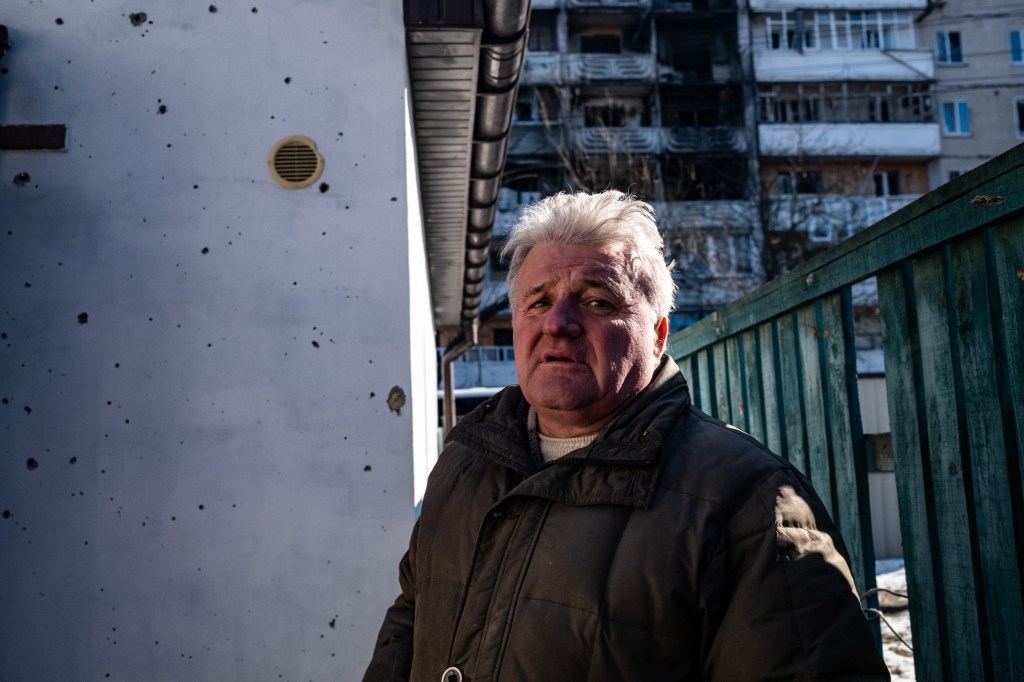IRPIN, Ukraine – In the hours after Russia launched its war against Ukraine one year ago, the view from Kyiv was that the Ukrainian capital could fall within days. People immediately began fleeing in the tens of thousands, as others lined up to collect weapons to use in the defence of the city. The image of Russian tanks rolling down the city’s streets wasn’t far from everyone’s minds.
But the quiet suburb of Irpin, just northwest of the city, would end up being as close as the Russians would get to taking Kyiv.
Videos by VICE
“The Russians shelled from that side, and Ukrainians from the other side,” said 66-year-old Irpin resident Sergiy, his arms pointing in both directions as he stood in the middle of towering apartment blocks partially destroyed by the fighting.

Like nearly every one of Irpin’s 60,000 residents, Sergiy fled with his family in early March, just over a week after the war began. Images of thousands of civilians trying to escape Irpin via a destroyed bridge shocked the world.
Russia wanted to conquer Kyiv but Ukrainian forces fought back in fierce urban fighting. Sergiy, who like the other people we spoke to in and around Irpin only gave their first names, watched the news closely as Ukrainian forces made surprising victories, and by the end of March routed the Russians, forcing them to abandon plans to take the capital.
In August Sergiy returned to his flat, but most of his neighbours have stayed away, their homes still missing windows or with too much damage to repair.
We found Sergiy greeting Zoya, one of the few neighbours who have returned, on her way to the grocery store. While some people are returning the area still lacks the communal feel its residents had grown accustomed to before the Russian invasion.

“[Life] doesn’t have any meaning like before the war. We lived, we had work, and it was stable,” she said. “It’s as if life has been cut short.”
All over the area construction workers can be seen paving over pockmarks from missiles, both in the streets and on buildings, and replacing windows and rooftops that were destroyed in the fighting. Signs with QR codes that people can scan to donate to reconstruction efforts hang from damaged balconies.
The Ukrainian government, with the help of international non-governmental organisations, has helped people in the area, including in neighbouring Bucha, to try to rebuild their lives despite the war raging in other parts of the country. Bucha was the scene of a massacre of Ukrainian civilians and prisoners by Russian forces, evidence of which emerged after they withdrew from the area, which weighs incredibly heavily on the people who have returned.
“We repair for our children and older people who came back, they need to understand that they can have medical support, cultural and sporting events and a normal life,” said Bucha’s deputy mayor Sergiy Shepetko. “They need to understand that while their husband and wives are on the front line they can still have a normal life here.”

He estimated that as many as 90 percent of the town’s inhabitants had returned in recent months. But the reconstruction efforts were still less than halfway complete.
“Every citizen of Bucha and of Ukraine is waiting for an end to the war. Russian forces need to leave our country and then we can start repairing everything.”
On Bucha’s once residential Vokzalna street, which during the assault on Kyiv became a “graveyard” for Russian armoured vehicles and symbolised their crushing defeat, dozens of workers lined both sides of the street getting orders from contractors, while others used their brief lunch break to nap under the midday sun.
One roofer, Dmytro, told us that the work was non-stop. He estimated it would take five years to rebuild the area completely to what it was before the war began.
Like many of the workers here, Dmytro is from the west of Ukraine, which has seen far less fighting than the east. He estimated that it would be five years before the towns like Bucha and Irpin could be completely restored. But, he said the herculean effort was possible if Ukrainians worked together.
While these areas that once saw intense fighting are being repaired, towns and cities elsewhere in Ukraine are still being destroyed in the fighting. And even around Kyiv, there’s widespread talk of a renewed Russian assault on or around the anniversary of the invasion similar to the one in February 2022.

Back in Irpin, local resident Valeriy, 59, was visibly shaken as he described his shock during those war’s early days, when the women and children in his family fled Ukraine. But he and his son, both barred from leaving under the country’s emergency powers, stayed.
Like most people here, Valeriy’s thoughts often drift 100 miles north to Ukraine’s border with Belarus, a close ally of Russia and from where Russia launched its invasion. Everyone is looking for any signs of troop build-ups. “Like [the Russians] did earlier, they can come and do it again.”
But that’s not going to stop him and his neighbours from trying to remake what they can of their lives before the 24th of February, 2022.
“Life goes on, what can we do,” he said. “We need to live.”





